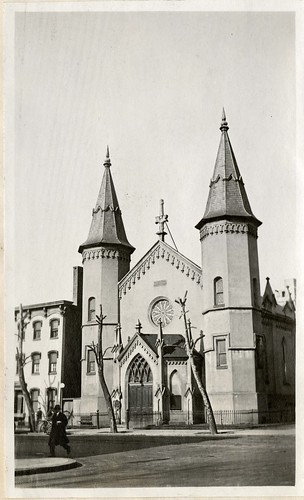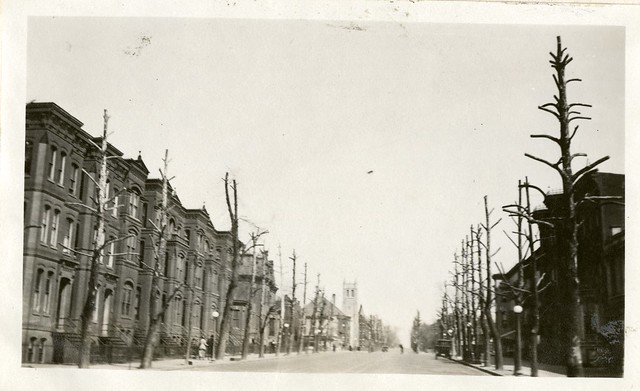Recently the Smithsonian Institution Archives posted some images from the Martin A. Gruber Photograph Collection, 1919-1924 (Record Unit 7355) which contains images of the National Zoo and Washington, DC, on the Smithsonian’s Flickr Commons. Before they went up, we gathered staff who are either native Washingtonians or very familiar with the city, to help identify the sites that our fantastic intern, Amanda Kaufman, wasn’t able to track down. We got through many of them, but a few left us scratching our heads and these images really fascinated me.
The scenes depicted are pretty generic—typical Washington row houses and a church—but here’s the weird thing—the trees are virtually naked; stripped down to their main trucks and branches. What is going on? Was it Dutch Elm disease or some other blight? Clues were few and, knowing nothing about Washington’s urban forest, I had to “branch out” and call on others to help get some answers.
Happily, an article appeared in the Sunday Washington Post, August 8, 2010, discussing Washington’s history as the “City of Trees.” It mentioned local author, Melanie Choukas-Bradley, who wrote City of Trees: The Complete Guide to the Trees of Washington, DC, and I thought she might be of help. So, I quickly formulated a question, attached the images, and sent them off to her. It was interesting being on the other end of a reference inquiry: I checked daily for an answer, and when it came I was really jazzed. It turns out that Melanie got on the case immediately and contacted other DC tree experts to weigh in on our mystery photos. And, over the ensuing days, I got e-mails from Melanie and her cohorts that peeled away the layers of information held in these images.
All agreed that this was not Dutch Elm disease (DED), which did not arrive in DC until the 1950s. So what was going on?
Mike Galvin and Mark Buscaino of Casey Trees, noticed that the one picture with people in it indicated that it was winter (they are bundled up against the breeze) and therefore the trees were in their dormancy. He looked into historical pruning practices and concluded that these were poorly pruned trees, and not ones that had been trimmed because of disease. Topping or pollarding was a common practice back then, whereby trees were radically pruned to encourage strong growth and inhibit messy and sometimes stinky fruiting (mulberries and ginkos). But not all tree species can withstand such radical surgery, which provoked yet another question:what species are captured in the images?
Mark and Jim (another tree expert from HortScience) enlarged each image to magnify the texture and coloring of the bark to see if that would help to identify them. He felt, based on the mottled bark and branching pattern, that the trees were sycamores/London plane (Plantanus), a common street tree deliberately planted by municipalities for their hardiness and leafy shade.
Finally, Dan Smith of American Forests provided a plethora of resources to explore to help determine the exact location of the trees based on species. Apparently, before and during the time these images were taken, detailed records were kept on trees planted by the city. He wrote that the Urban Forestry Administration (Department of Transportation) may have some of these records. Better yet, if we could identify the streets, the Army Corps of Engineers published a detailed district infrastructure report in the 1870s that documented street trees by location and species. A hard copy of this report is at the DC Historical Society and digital copy online at the Library of Congress (although I have yet to find it online). Wow!
In the end, these few images sparked a real adventure that was very satisfying because of all the cooperation and new information I (a native Washingtonian) learned. Needless to say, I hope that someone might recognize buildings or other signs and let us know where these scenes were taken—the recent photo IDs from our readers and Flickr Commons fans prove that it sometimes happens, and we love when it does. Then the hunt can start anew to find to ultimate ID for the trees and maybe see if any are still here today. Perhaps someone will snap picture and we’ll do a Then & Now posting. That would be so cool!
Produced by the Smithsonian Institution Archives. For copyright questions, please see the Terms of Use.




Leave a Comment